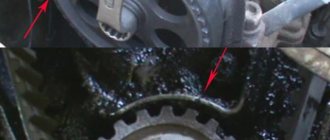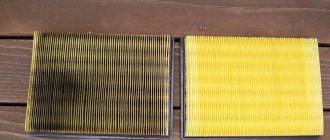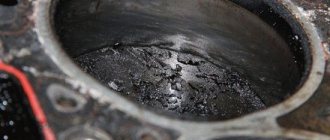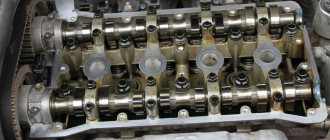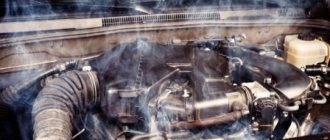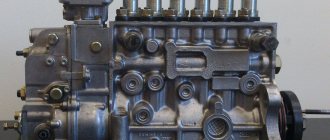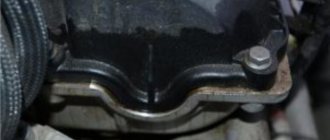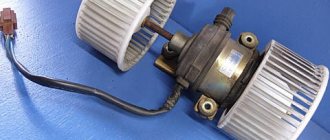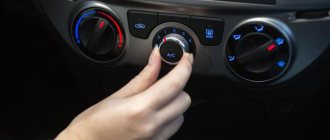Main reasons for increased consumption
As already noted, there is a distinction between permissible consumption - this is oil for waste. Simply put, regardless of the type of internal combustion engine, a small part of the lubricant is burned in it during operation. The fact is that the lubricating fluid circulates in the system and gets onto every element of the engine, including the cylinder walls.
Each piston is equipped with special rings that collect residual lubricants from the walls of the combustion chamber into the crankcase. However, a small part still remains on the cylinder walls and burns along with the mixture of gasoline and air. Thus, lubricant consumption should be from 0.05% to 0.25% of the volume of burned fuel. For example, if the engine consumed 100 hp. gasoline, then the permissible lubricant consumption should be no more than 25 g. However, this is the maximum figure. The minimum consumption is up to 5 g. This is all an acceptable limit. If deviations are observed, then it is worth considering why a diesel engine eats oil.
On new units, lubricating fluid may not be consumed at all. But this happens when the engine is completely new. As the main mechanisms wear out, this figure will increase. If the consumption is scary, you should look for the reason. And in order to eliminate it, you will have to disassemble the entire engine. Also, the reason may be simple, which can be easily eliminated. Next - about the main malfunctions that lead to increased lubricant consumption.
Wrong choice of engine oil
Each manufacturer recommends for a particular model of machine and engine a specific type of lubricant that has optimal characteristics. If for any reason a car owner uses oil of a different viscosity, this leads to increased waste, and the engine needs to be topped up with oil almost every 2-3 thousand kilometers.
Severe wear of oil scraper rings
The pistons of any internal combustion engine have special oil scraper rings - one for each piston. They, as already noted, are needed to protect the cylinders from lubricants getting into them. Since the rings are in close contact with the walls of the combustion chamber, and at the same time it is associated with constant friction, they tend to wear out. If there is wear, then the gaps through which lubricating fluids will enter the combustion chamber will increase. There, the lubricant will safely burn together with the fuel mixture, and then exit into the exhaust system in the form of smoke. This is the answer to the question why the engine eats oil and smokes.
Also, in case of severe overheating of the engine, the rings can lie down - they lose their elasticity and are pressed in their seats against the pistons. Diagnose the problem by the characteristic blue smoke from the exhaust pipe. You can fix the damage by replacing these same rings.
Exhaust color determination
This operation must be done by two people. One press on the gas pedal or the drive/throttle handle/injection pump raises the engine speed to 2-3 thousand. The second one looks to see if the engine is smoking. On diesel engines, when you press the gas pedal sharply, black smoke may appear, which disappears after lowering the engine speed. Gray or bluish smoke, which intensifies as the engine speed increases, indicates that oil has entered the cylinders through caps, rings or a broken gasket, so they need to be replaced. If the exhaust is clear, the caps, rings and gasket are fine.
Finding leaks
A car with severe leaks leaves oil stains on the asphalt and requires urgent repairs. Weak leaks only appear when the engine is running under load, so they leave no traces on the ground. There should be no traces of oil on the surface of a fully functional motor. If you find a greasy wet or damp spot, then there is a leak in that place. To clarify, you need to start the engine and leave it idling to warm up to operating temperature, and then inspect the suspicious area again.
To avoid carbon monoxide poisoning, this must be done outside the garage, in the open air.
If it does not become wet, you need to gradually, within a minute, raise the speed to maximum and carefully observe the suspicious area. If this does not help detect the leak, you will have to drive the car 10-20 kilometers, accelerating sharply from time to time. In this mode, the pressure in the combustion chamber is much higher than usual, therefore the amount of gases breaking into the crankcase is noticeably greater. If after such a check the suspicious place gets more wet, the problem is a malfunction of the crankcase ventilation system and poor tightening or damage to the gasket.
Checking the crankcase ventilation system
To do this, unscrew the fastening clamps and remove the PCV valve, then blow it with lips or a compressor. If it is working properly, then the air will flow only in one direction with little effort. After this, you need to remove and blow out all the hoses, then check the pipes. One of them may be clogged with dirt or sediment.
Leakage through valve stem seals
The oil seal is a special oil seal in the engine. It is made of special materials that can easily withstand high temperatures. Due to severe wear, the oil seal loses its elasticity characteristics. The result is leakage and high lubricant consumption.
To replace the caps you only need to remove the cylinder head. It is not necessary to disassemble the entire engine. This is the least expensive reason for an engine to eat oil to fix. Subaru engines often suffer from this problem. Many owners of these cars complain about high consumption. Some write that this is a normal phenomenon and these engines actually have such a design (opposite). However, a common reason why the engine on a Subaru ej20 eats oil is the valve stem seals.
Cylinder head gasket leaks
This defect most often appears on used cars. On new ones this does not happen at all - under production conditions the bolts are tightened very well. On cars with high mileage, where the engine wear is already quite high, the gasket simply burns out. This happens quite often.
To fix the problem, the gasket needs to be replaced. To do this, you simply need to remove the cylinder head. After the new one is installed, it is recommended to tighten the bolts evenly so that the leak does not form again.
Ways to eliminate high oil consumption
Typically, problems with excessive oil consumption can be resolved by removing and disassembling it. Complete disassembly of the motor is not always necessary; sometimes it is enough to remove only the head. Experienced drivers say that the use of synthetic oil instead of mineral oil creates a large waste of oil and its leakage along the cylinder head gasket.
The process of removing and disassembling the power unit for a certain brand of car is carried out according to the manual for the car. If you decide to fix the problem yourself, you must carefully study the manufacturer’s recommendations, otherwise you will not be able to eliminate the problem of oil leakage.
Frequent malfunctions
Lubricant flows through the oil filter. One of the characteristic signs is smudges and stains under the car after parking. The cause of the leak is a loose filter housing. You can easily get out of this situation - just tighten the filter more tightly. This will fix the leak instantly.
Also, car enthusiasts are faced with a leak through the cylinder head cover. In most car models it is secured with 6-12 bolts. Some of them may simply not be enough. Low quality oils also lead to increased consumption. The fact is that when lubricants get on the piston, they burn instantly. It is recommended to fill in with a higher quality product and then the consumption will return to normal.
Diesel engines
We've looked at gasoline engines, and now we'll look at why a diesel engine eats oil. High consumption if 1 liter of lubricants is consumed per 10,000 km. The reasons for oil consumption in diesel engines are generally the same as in the case of gasoline engines. Grease may leak through the crankshaft oil seal. Leaks also occur through the cylinder head gasket or oil seals. It is recommended to check the injection pump. In 25% of such cases, this is where the problem lies. Fuel injection pump failures are different. In one case you can get by with repairs, in others you will need replacement. Among the reasons why the KamAZ engine consumes oil is long operation at idle speed. Leaks are also often observed through the lubrication system of the turbocharger - to eliminate this, tighten the connections in the turbocharger system or change the gaskets. A clogged air cleaner and air intake also lead to high consumption. This can be easily resolved by cleaning it.
Where does the oil go in a healthy engine?
A car with a working engine consumes motor oil in small volumes - from 20 to 40 grams per 1000 km. If the car is operated in extreme conditions, when driving at high altitudes of more than 2000 meters, when driving uphill, with frequent acceleration, then engine oil consumption increases to 200 grams per thousand km. If oil consumption occurs in large volumes, then you should deal with it. Usually the main cause is oil evaporation due to increased engine temperature.
An increase in engine temperature, detonation and other negative factors can be influenced by changes in the composition of the combustible mixture and disruption of the ignition system. These factors, in turn, affect engine oil consumption and lead to serious repairs to the power unit.
Increased appetite after major repairs
It also happens that a completely repaired engine does not please its owner. To understand the reasons, it is necessary to understand what kind of repairs were made. Perhaps the pistons were not changed, but only the rings were replaced - they will take a long time to break in with oval pistons.
In fact, there are many reasons why an engine eats oil after a major overhaul. And to find the fault, it is best to disassemble the motor and inspect it. But this is recommended only for professionals.
